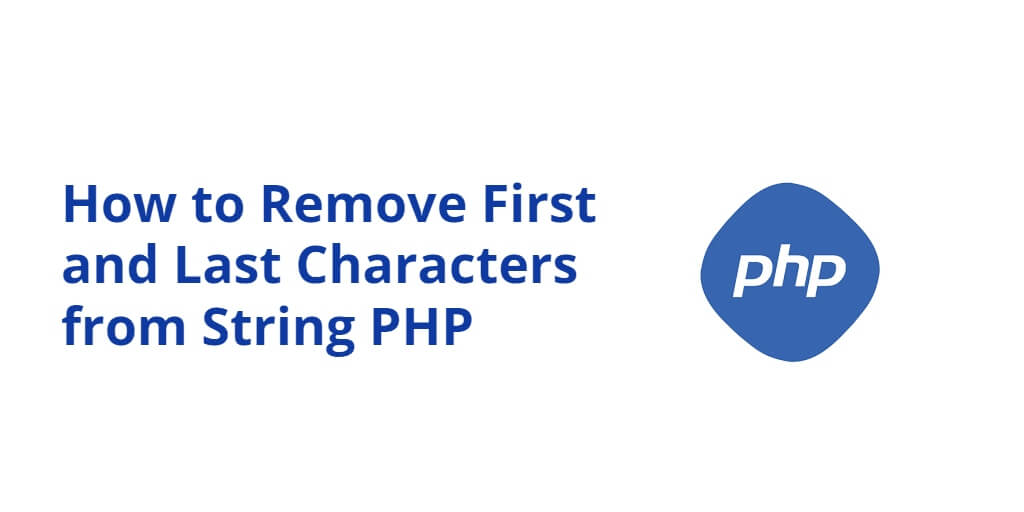In PHP, removing the first and last characters from a string is a basic task. This operation can be useful when dealing with strings that have extra or unnecessary characters at the beginning or end. In this tutorial, You will learn different methods for removing the first and last character from a string in PHP.
PHP Remove First and Last Character from Strings
Removing the first and last characters from a string in PHP can be achieved using several different methods, including substr, trim, and preg_replace.
- Method 1: Using substr() function
- Method 2: Using trim() function
- Method 3: Using preg_replace() function
Method 1: Using substr() function
The substr() function in PHP can be used to extract a portion of a string. By specifying the start position and length, you can extract a substring from a given string. To remove the first and last characters from a string, you can use substr() function twice – first to extract the substring without the first character, and then again to extract the substring without the last character.
Here is an example code snippet that demonstrates this method:
<?php $str = "Hello World!"; $str = substr($str, 1, -1); echo $str; ?>
The given code is written in PHP, and it performs the following actions:
- The string “Hello World!” is assigned to the variable $str.
- The substr() function is used to extract a portion of the string starting from the second character (index 1) up to the second-to-last character (index -1). This means that the first and last characters of the original string are excluded. The resulting substring is then assigned back to the $str variable.
- The echo statement is used to display the updated value of $str, which is “ello World”.
So, when you run this code, it will output “ello World” as a result, which is the substring of the original string “Hello World!” with the first and last characters removed.
Method 2: Using trim() function
The trim() function in PHP is used to remove whitespace or other characters from the beginning and end of a string. By default, trim() removes whitespace characters such as spaces, tabs, and line breaks. However, you can also specify a list of characters to be removed from the string.
To remove the first and last characters from a string using trim(), you can pass the characters to be removed as a second argument to the function.
Here is an example code snippet that demonstrates this method:
<?php $str = "Hello World!"; $str = trim($str, "H!"); echo $str; ?>
The above given PHP code performs the following actions:
- The string “Hello World!” is assigned to the variable $str using the assignment operator “=”.
- The trim() function is called with two arguments: the string to be trimmed ($str) and the characters to be removed from the beginning and end of the string (“H!”).
- The trim() function removes any occurrences of the characters specified in the second argument from the beginning and end of the string specified in the first argument. In this case, it will remove the “H” and “!” characters from the beginning and end of the string “Hello World!”, respectively.
- The trimmed string is assigned back to the same variable $str using the assignment operator “=”.
- Finally, the trimmed string “ello World” is outputted to the screen using the echo statement.
So the output of this code will be “ello World”.
Method 3: Using preg_replace() function
The preg_replace() function in PHP is used to perform regular expression-based search and replace operations on a string. you can use this function to remove the first and last characters from a string by using a regular expression pattern that matches the first and last characters and replacing them with an empty string.
Here is an example code snippet that demonstrates this method:
<?php
$str = "Hello World!";
$str = preg_replace('/^.|.$/', '', $str);
echo $str;
?>
The above given code is a PHP script that performs a string manipulation operation using a regular expression pattern.
Here is what each line of the code does:
$str = "Hello World!";: This line initializes a string variable$strwith the value “Hello World!”.$str = preg_replace('/^.|.$/', '', $str);: This line replaces the first and last characters of the string with an empty string using thepreg_replace()function. The regular expression pattern/^.|.$/matches either the first character of the string (^.) or the last character of the string (.$), and replaces it with an empty string.echo $str;: This line outputs the modified string to the screen, which in this case would be “ello World” without the initial “H” and final “!” characters.
Overall, the code removes the first and last characters of the original string using regular expressions and outputs the modified string.
Conclusion
In this tutorial, you explored different methods for removing the first and last characters from a string in PHP. you learned how to use the substr(), trim(), and preg_replace() functions to achieve this task. All three methods are equally effective and can be used depending on the specific requirements of the program. By understanding these methods, you can easily manipulate and modify strings in your PHP programs.
